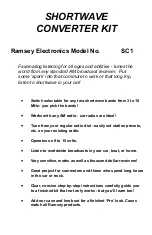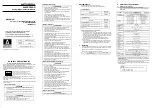
Page 38 MS-SOUND decoders MS440 to MS990
Smoke generator without fan (Example: Seuthe 18 V):
In addition to a simple ON/OFF function via a function output of your choice, the smoke intensity can
also be programmed to change between
standstill, or cruising
and
acceleration
.
Therefore, the smoke generator has to be connected to one of the function outputs
FO1…FO8
and the
selected output must be programmed with the associated “effect CV” (with CV #127 for FO1, CV #128 for
FO2 etc.); in this case smoke generation of steam engines (effect code “72”) or diesels (effect code “80”).
The smoke generator characteristic as defined by CV #137, #138 and #139 is used for the relevant
function output.
Those CVs must be programmed (with appropriate values) otherwise the smoke generator will not pro-
duce any smoke.
EXAMPLE: Typical characteristic for a track voltage set around 20 V with above smoke generator (18 V):
CV #137 = 70 – 90: Little smoke at standstill.
CV #138 = 200: The smoke intensity is increased to about 80% of its maximum capacity
beginning with speed step 1 (at very low speed), which produces relatively heavy smoke.
CV #139 = 255: The smoke generator is driven to its maximum under acceleration, which results in thick smoke.
Synchronized steam chuffs or typical diesel smoke (with exhaust fan):
The heating element of the smoke generator is connected – as in the example above with the “Seuthe”
generator – to
FO1 - FO8.
The fan is connected to the function output
FO4
(in some decoders on
FO2
).
See chapter “Installation and wiring”.
Small decoders
:
fan is connected to
FA4
(against positive pole) (for this CV #133 = 1 is set).
Large
d
ecoders:
Fan could also be connected to output FA4, but it is considerably better to:
Use the
special outputs
Ventilator
V1
and
V2
(against
ground
). These outputs are advantageously
designed for the purpose (unlike normal function outputs): working on 5 V basis (like the usual fan mo-
tors) and equipped with the possibility of braking between steam hammer pulses (which better sepa-
rates the ejected steam clouds).
For
fan V1
(the only one used when there is only one smoke generator) there are settings in CVs
#351, #352, #355 (see table below).
If
two smoke generators
are used, i.e. 2 heaters and 2 fans (whether in one housing or completely
separated from each other), the two heaters are connected to different function outputs, both of which
must be assigned the appropriate effect (VAPOR or DIESEL or possible future variants), e.g.
STEAM: CV #159 = 72 and CV #160 = 72 or DIESEL: CV #159 = 80 and CV #160 = 80
(Assuming that the two heating elements are connected to FA7, FA8)
The lower of the two function outputs (i.e. in the example the smoke generator on FA7) is then auto-
matically assigned the first fan output (i.e. V1), the higher the second (V2).
For
fan V2
the setting CVs are located in a separate CV page…
(Information will be added.)
CV
Denomination
Range
Default Description
#133
Using FO4 as
a normal function output
or
FO4 as output for
Steam fan of the
Smoke generator of
steam locos
and
IN (reed) pins
Configuration
and
MS440: FA9 at pin IN4
0
= 0 (Default): FO4 is used as normal function output
so it’s controllable by function key instead of
a cam sensor.
= 1: FO4 for smoke-fan which is usually controlled by a
real or “virtual” cam sensor. Also see CVs #267,
#268!
NOTE
: The fan operation is also determined by the
sound project.
NOTE
: Large-scale decoders do have special outputs
and additional configuration possibilities for smoke
fans!
Bit 4 - Input IN1 is inverted
Bit 3 - Input IN2 is inverted
Bit 2 - Input IN3 is inverted
Bit 5 - Input IN4 is inverted
Bit 6 - (only type MS440) Pin IN4 becomes output FA9
#137
#138
#139
Definitions of
Smoke generator char-
acteristic, connected to
FO1 – 6.
PWM at stand still
PWM at steady speed
PWM during accelera-
tion
0 - 255
0 - 255
0 - 255
0
0
0
This is valid, if in one of the CVs #127 - #132 has set
on of the function effects “smoke generation” (i.e. “72”
or “80”): The values in CVs #137 – #139 define a char-
acteristic for the function outputs (FO1 - FO8; referred
to below as FOx).
CV #137: PWM of FOx at standstill
CV #138: PWM of FOx at steady speed
CV #139: PWM of FOx at acceleration
#351
Speed of the smoke fan
at constant speed for
DIESEL locos
1 - 255
128
The speed of the fan is set by PWM;
the value of CV #351 defines the behavior during
normal driving.
= 128: Half voltage (PWM) when driving.
#352
Speed of the smoke fan
during acceleration and
engine starting for
DIESEL locos
1 – 255
255
To create a cloud of smoke when starting the engines,
the fan is set to higher (usually maximum) speed, also
in case of strong acceleration during operation.
= 255: Maximum voltage during start-up.
#355
Speed of the smoke fan
at constant speed for
DIESEL locos
1 – 255
0
CV #355 sets the speed of the fan at standstill - with
sound on. This has the effect of emitting smoke (a
small amount, but visible) even at standstill.
Decoder with 2 smoke fans (z. B. MS950, MS990)
For the second fan (V2) are
CV page 145/0
(i.e. page pointer CV #31 = 145, CV #32 = 0),
CVs #500 - #511
(if necessary also for several other fans) available. The second fan is automatically assigned to the
higher function output with effect "smoke generation" (i.e. where second heating element is connected).
CVs (from SW-Version 5)
Description
Select page:
CV #31 = 145, CV #32 = 0
CV-Page 145/0 >
CVs #501, 502, 505
SW version 5.00 or higher
Identical meaning as CV page 0 (main page) > CVs #351, #352, #355 (there for
fan V1), but fan -output V2.
















































